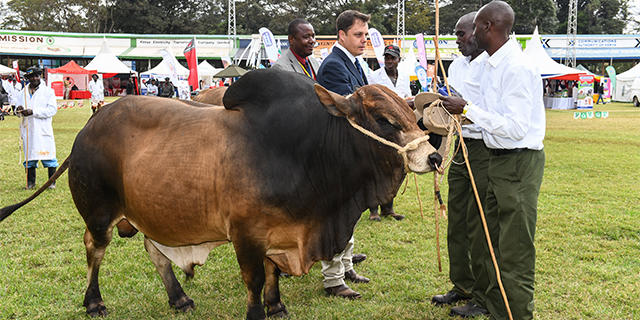Cattle farming is one of the most practiced agripreneurship, especially in the ASAL parts of the country where crop farming is undoable.
Most of the cattle kept in these areas are primarily for beef. It is estimated that the ASAL areas account for about three-quarters of the estimated 14 million beef cattle reared in the county.
The Boran cattle breeds are the most reared owing to their superior characteristics. They have the ability to withstand periodic shortages of water and feed, the ability to walk long distances in search of water and feed, and the ability to digest low-quality feeds.
While some farmers feed their cattle freely in the open fields, others have realized an intensive feeding technique for the animals to acquire market body weight quickly.
Why you should go for Brahman breed when beef farming
Known as feed lotting, this feeding technique helps the cattle to acquire market weight quickly, helping farmers with a small space to rear as many cattle as possible within a given time frame.
Animals are kept in confinement and fed quality feed for maximum weight gain. The diet is majorly high in carbohydrates, sufficient proteins, and optimum mineral salts.
According to Moses Olum, a researcher at the Kenya Agricultural and Livestock Research Organisation (KARLO), the desired market weight is usually attained from 60-120 days of quality feeding.
During this period, these animals can gain between 50-200 kilos depending on age and nutrition. The feed can be compounded from locally available products such as maize grains, cotton or sunflower seed cakes, and mineral premixes available from various manufacturers.
What is the Best Feed for Fattening the Cattle
According to various sources, the ideal feed for cattle fattening should contain roughage and grain. The roughage content should be higher than the grain when introducing cattle to feedlots.
Over time, the grain must be increased slowly, and roughage correspondingly decreased. Barley is the best grain for lot-feeding cattle, but sorghum, maize, and oats can also form a nutritious diet.
Oats is not an ideal grain for cattle fattening on its own but can be used with any other grain. Hay or Silage could be used as the source of roughage.
Beef Farming in Kenya: Buy a cow at Sh 18,000 sell it at Sh 54,000
Where Can You Get the Feed From?
There are companies in the country that sell cattle fattening feed, among them the Belfast Millers Ltd. These are complete, well-balanced feeds specifically made for fattening beef cattle.
You can also make homemade fattening feeds using the aforementioned ingredients. Remember, the cattle will only attain the desired weight if you feed it the required nutrient levels.
The amount of feed the animal consume will depend on factors such as live weight and age. The daily feed intake per animal averages between 8-15kg, while the daily weight gain of a cattle weighing 350 kg is estimated at 1.6 kg.
It is also worth noting that the right market weight cannot be achieved without the right animal handling mechanisms. The cattle should enter the lot system disease free and should be regularly vaccinated and dewormed to keep off diseases.
The cattle shed should also be spacious, well-ventilated, and generally comfortable for the cattle to protect them from external stress.
Farmers Profiting from the Feedlot System
Various farmers in the country have attested that the feedlot system is the real deal for any farmer looking to rake the cash in beef livestock farming.
A good example is a team of investors who have put up the 2-acre Pioneer Feedlot in Chaka, Nyeri County. They also run a feed mill in Chaka Town, where they formulate feeds for the animals.
Dr. Gakuo, the managing partner, says he travels to various livestock markets where he buys cattle for between Sh18,000 to Sh30,000, depending on the breed. Most of the animals are emaciated or underweight at the time of buying.
3 tips on how to compare beef and dairy cattle
After three months of intensive feeding, he sells an animal at between Sh60,000 and Sh90,000. With a capacity of handling up to 800 cattle per batch, the ranch is in good business with economies of scale.
“I can assure you that feedlot farming for beef cattle can greatly increase the livestock earnings to pastoralists, reduce grazing pressure on the rangelands, reduce the effects of climate change, and reduce cattle rustling,” he said.








